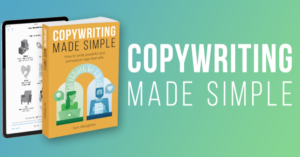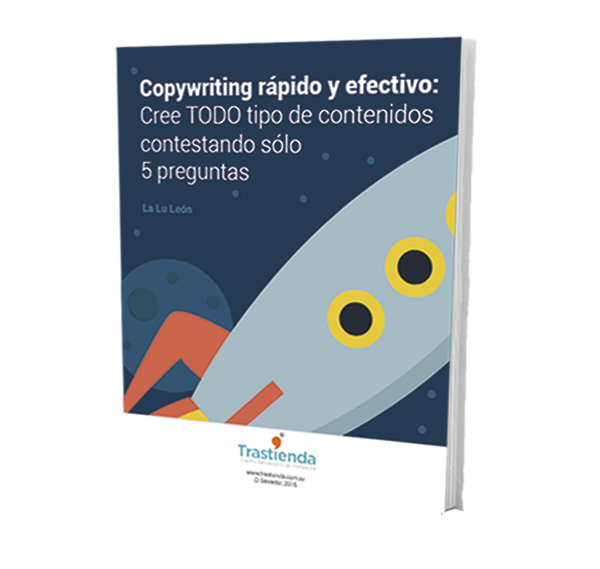En plena cuarentena, me decidí a solicitarle una entrevista a Tom Albrighton. Él es un referente del copywriting británico por su trabajo desde hace más de 15 años al frente de ABC Copywriting; es cofundador de la Professional Copywriters’ Network, la asociación líder en el Reino Unido para escritores comerciales, y es el autor del libro “Copywriting Made Simple” del que puede conocer más aquí.
Tal como lo he mencionado antes en otras entradas, él es uno de mis copywriters favoritos. Su forma de entender y explicar el copywriting me parecen fenomenales. Su sitio web es impecable. Y su blog es imperdible. Así que ahora me siento muy feliz de compartirle lo que “platiqué” con él vía correos electrónicos.
Al plantear las preguntas para esta entrevista pensé en el contexto único que estamos atravesando: muchas marcas están dándole un giro de 180 grados a su plan de marketing 2020 en cuestión de días o semanas y, por ello, están creando o ajustando sus sitios web un poco a la carrera, “lanzándose” al e-commerce lo mejor que pueden, o buscando la mejor manera de comunicarse a través de redes sociales. Y, en todas esas labores, muchas están dejando de lado la calidad y efectividad de sus mensajes.
Le agradezco muchísimo a Tom por su tiempo y por sus respuestas sinceras y esclarecedoras que se suman a la conversación global sobre el rumbo del marketing, las comunicaciones y las ventas en este #newnormal que apenas estamos vislumbrando.
¡Aquí está lo que conversamos!
1.En general, ¿cómo les ayuda el copywriting a las marcas para su comunicación offline y online?
TA: El copywriting crea los mensajes que dan vida a las marcas. A través de las palabras, el copywriter expresa la promesa central de una marca y ayuda al lector a experimentar la marca antes de comprar. Al hacerlo, los alientan a dar el primer paso y probar la marca. Esto es lo mismo online, offline y en todos los canales de marketing.
2. ¿Qué les diría a las personas que han gastado mucho dinero en una web “bonita”, pero no le han dado importancia a los textos?
TA: Yo les diría, “¿Por qué gastas tanto en papel de regalo cuando no hay nada dentro de la caja?”
El objetivo de un sitio web es su mensaje, no su presentación. Podría decirse que esto fue más claro en los primeros días de la web, cuando las personas solo podían usar formatos de texto simples. Cuanto más sofisticado sea el diseño web, más fácil será perder de vista el objetivo.
3. ¿Cuáles son los errores de copywriting que más ve en las redes sociales de sus clientes?
TA: ¡Todos mis clientes son maravillosos! Pero si está preguntando sobre errores comunes, el principal es el ensimismamiento. Los copywriters redactan los mensajes «hacia afuera», para responder a las preocupaciones de las audiencias. Gran parte del contenido de las marcas en redes sociales se centra en ellas mismas, hablando de sus preocupaciones e intereses. Por lo tanto, es poco probable que encuentren una audiencia amplia, más allá de las personas que ya están interesadas.
4. ¿Cuál es el mejor libro de copywriting que ha leído y por qué considera que es el mejor?
TA: Ahora estoy leyendo “¿Vende tu marketing?” de Ian Moore. Lamentablemente, ahora está agotado, pero aún se pueden obtener copias de segunda mano.
No es realmente un libro de copywriting; pero es una excelente guía para las comunicaciones de marketing, de un autor que de verdad ha trabajado en ello. Es realmente práctico y analiza las ideas más básicas sobre cómo captar realmente la atención de las personas, expresar sus inquietudes y hacer que actúen. Además, es fácil de leer y divertido.
5. ¿Por qué se convertió en copywriter?
TA: Tenía un trabajo de tiempo completo como escritor y editor y, cuando me despidieron, comencé a trabajar independientemente sin saber realmente qué pasaría. Después de un tiempo me di cuenta de que debía llamarme copywriter, a pesar de que ese no había sido mi papel antes, para que los clientes entendieran cómo podía ayudarlos. Y todo creció a partir de ahí.
¡Para ser honesto, no había realmente un “por qué” para mí!
6. ¿Qué es lo mejor y lo peor de ser copywriter?
TA: Lo mejor, para mí, es la variedad. Poder escribir sobre tantos productos y servicios diferentes, y aprender cosas sobre ellos que nunca imaginé.
Trabajo solo, de forma independiente, generalmente sin el apoyo de un director de arte, director creativo, etc. Entonces, para mí, lo peor es no tener a alguien que me dé confianza en mis propias ideas o que me diga cuándo voy por el camino equivocado. Solo puedo usar al cliente como mi caja de resonancia.
7. ¿Qué le funciona para superar el famoso “bloqueo del escritor”?
TA: Cambiar de lugar. Hacer ejercicio. Consultarlo con la almohada. Leer algo irrelevante. Básicamente, cualquier cosa para sacudir la mente y obtener una visión diferente del proyecto. Lo peor que se puede hacer es sentarse allí, sin progresar y castigándose por ello.
8. ¿Cómo deberían “hablar” las marcas con sus públicos internos y externos a medida que se desarrolla la pandemia del COVID-19?
TA: Externamente, creo que las marcas solo deberían hablar cuando tienen algo importante y relevante que decir. El contexto es importante. Cuando cada marca ofrece los mismos mensajes tranquilizadores, el efecto general para los lectores es simplemente irritante, y cada mensaje individual se olvida. Así que creo que una «política de silencio» definitivamente es algo a considerar, y creo que muchas marcas lo han elegido.
Por otro lado, estamos comenzando a darnos cuenta de que la pandemia podría estar con nosotros durante mucho tiempo, por lo que realmente no hay prisa por difundir su mensaje. Puede tomarse su tiempo para hacer que sus comunicaciones sean correctas, y es posible que también tengan que evolucionar con el tiempo. Esta no es una ocasión única en el calendario de contenido, como el Día de San Valentín o el Viernes Negro.
De hecho, respeto a las marcas que obviamente han decidido que no pueden hablar sobre la crisis con autoridad, por lo que simplemente continúan con sus mensajes normales. Todos queremos volver a la vida normal así que eso, en sí mismo, es bastante tranquilizador.
No soy un experto en comunicación interna, pero imagino que los empleados buscan comunicaciones directas y honestas que «digan las cosas como son». Como todos dicen, estos son tiempos inciertos. Por lo tanto, hay que tratar de reducir la incertidumbre tanto como sea posible, brindando a las personas información oportuna y una guía clara.
9. A partir de su experiencia, ¿cuál cree que es el futuro del copywriting en los próximos tres años?
TA: Bueno, no estoy seguro de cuán útil sea mi experiencia, porque el futuro puede ser completamente diferente del pasado. Creo que vamos a ver una reevaluación exhaustiva de lo que las marcas deberían decir y cómo lo dicen. Las personas analizarán detenidamente el «propósito” de las marcas y, posiblemente, decidirán que ya no son relevantes.
Al mismo tiempo, sin embargo, todos anhelamos la normalidad, por lo que podríamos encontrar que las cosas no cambian tanto como pensamos. Si bien algunas marcas habrán adaptado sus ofertas a un mundo de “quedarse en casa”, habrá otras que, simplemente, no podrán, por lo que empujarán un mensaje de “regreso a la normalidad” tan duro como puedan. Será interesante ver lo que se considera aceptable en esa área, en términos de alentar a los consumidores a hacer cosas que sean legales y permitidas, pero que aún podrían ponerlos en peligro.
Habiendo dicho todo esto, el copywriting no va a desaparecer. Mientras tengamos una economía reconocible, las marcas siempre lo necesitarán para encontrar los mensajes correctos para sus productos. ¡Así que a eso me aferro!
Y ahora, si prefiere leer la entrevista en inglés, tal como Tom la contestó, aquí está 👇
1.In general, how does copywriting help brands for their offline and online communication?
TA: Copywriting creates the messages that give brands life. Through words, the copywriter expresses the core promise of a brand, and helps the reader experience the brand before they buy. By doing so, they encourage them to take the first step and try the brand. This is the same online, offline and in every marketing channel.
2. What would you say to people who have spent a lot of money on a «nice» website, but have not paid attention to the texts?
TA: I would say, ‘Why are you spending so much on gift wrap when there’s nothing inside the box?’
The whole point of a website it its message, not its presentation. Arguably, this was clearer in the early days of the web, when people could only use simple text formats. The more sophisticated web design gets, the easier it is to lose sight of the goal.
3. What are the copywriting mistakes you see the most on your clients’ social media?
TA: All my clients are wonderful! But if you’re asking about common mistakes, the main one is self-absorption. Copywriters make messages ‘face outwards’ so they speak to the concerns of the reader. A lot of social media content is inwardly focused, speaking to the concerns of the company or the brand itself. So it’s unlikely to find a wide audience, beyond people who are already interested.
4. What is the best copywriting book you have read and why do you consider it to be the best?
TA: I’m going for ‘Does Your Marketing Sell?’ by Ian Moore. It’s sadly now out of print, but you can still get second-hand copies.
It’s not really a copywriting book, but it is an excellent guide to marketing communications, from an author who has been there and done it. It is really practical, and looks at the most basic ideas of how you actually get people’s attention, speak to their concerns and get them to act. Plus it’s very readable and funny.
5. Why did you become a copywriter?
TA: I had a full-time job as a writer and editor, and when I was laid off, I began freelancing without really knowing what would happen. After a while, I realized that I should call myself a copywriter, even though that hadn’t been my role before, so clients would understand how I could help them. And it all grew from there.
So to be honest, there wasn’t really much of a ‘why’ for me!
6. What is the best and worst thing about being a copywriter?
TA: The best thing, for me, is the variety. You can write about so many different products and services, and learn things about them you never imagined.
I work alone, on a freelance basis, usually without support from an art director, creative director and so on. So for me, the worst thing is not having someone to give me confidence in my own ideas, or to tell me when I’m going down the wrong path. I just have to use the client as my sounding board instead.
7. What works for you to overcome the famous “writer’s block”?
TA: Change venue. Take exercise. Sleep on it. Read something irrelevant. Basically, anything to shake up your mind and get a different view on the project. The worst thing to do is just sit there, making no progress and beating yourself up about it.
8. How should brands “talk” to their internal and external audiences as the COVID-19 pandemic unfolds?
TA: Externally, I think brands should only speak when they have something important and relevant to say. Context is important. When every brand is offering the same bland message of reassurance, the overall effect for readers is just irritating, and each individual message is forgotten.
So I think a ‘policy of silence’ is definitely something to consider, and I believe many brands have chosen this. We’re also beginning to realize that the pandemic could be with us for a very long time, so there’s really no rush to get your message out. You can take your time to get your communications right, and they may have to evolve over time too. This isn’t a one-off occasion in the content calendar, like St Valentine’s Day or Black Friday.
I actually have respect for brands who’ve obviously decided they cannot speak about the crisis with authority, so they’re just continuing with their normal messaging. We all want to get back to normal life, so that is quite reassuring in its way.
I’m not an expert on internal comms, but I imagine employees will be looking for straightforward, honest communications that just ‘tell it like it is’. As everyone keeps saying, these are uncertain times. So aim to reduce uncertainty as much as you can, by giving people timely information and clear guidance.
9. Based on your experience, what do you think is the future of copywriting in the next three years?
TA: Well, I’m not sure how useful my experience is, because the future may be completely different from the past. I think we’re going to see a thorough re-evaluation of what brands should say, and how they say it. People will take a long, hard look at ‘brand purpose’, and possibly decide that it’s no longer relevant.
At the same time, though, we are all longing for normality – so we might find that things don’t change quite as much as we think. While some brands will have adapted their offerings to a ‘stay at home’ world, there will be others who simply can’t – so they’ll be pushing a ‘back to normal’ message as hard as they can. It will be interesting to see what is considered acceptable in that area, in terms of encouraging consumers to do things that are legal and permitted, but could still put them in harm’s way.
Having said all that, copywriting is not going away. As long as we have a recognisable economy, brands will always need writers to find the right messages for their products. So that’s what I hold on to!
¡Hasta la próxima!



